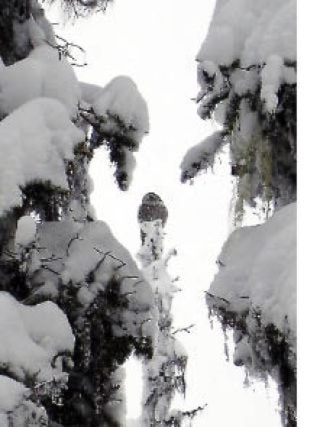The days are getting longer, when the sun comes out we can feel the warmth emanating into our cold winter bones.
Coming up on Feb. 18 - 21 is the Great Backyard Bird Count. It is astounding how many birds we see in the backcountry in the middle of our dark and cold winter.
Just last Sunday I enjoyed watching an American Dipper on an ice shelf near the shore of the North Thompson River near Otter Creek. This is the bird with a bad bobbing habit; of course this is a protection and deceit mechanism that mimics the riffles and waves of a stream. The dipper not only dunks his head into the water to retrieve larvae and insects but it will completely dive in and submerge itself.
Then as I was departing the parking area for the North Blue River valley, I got a low fly over from my friend the Bald Eagle. This intimidating bird was very curious and gave me the stare down as he flew only a few meters above my head. Later that same day, while skiing up the valley, a small but very beautiful Downy Woodpecker was busy gleaning tiny insects from the canopies of some small trees.
I must confess that one of my favorite avian friends in the backcountry is the Northern Hawk Owl. For years while camping near tree line during the winter months, we would listen to the most unusual birdcall. Northern Hawk Owls do not have a typical sounding owl like “hoot” but more of a series of long lonely notes that emanate from the forest canopy. Very similar to the birdcalls that we hear in the desert of Utah or Arizona. I later discovered the Northern Hawk Owl hunts during the day in forested habitats. Perching themselves on the very top leader of trees in order to spot prey which consists of voles, squirrels and I believe fine dining on Pine Marten. These birds depend on large dead trees with
cavities for nesting. Sometimes woodpeckers carve the holes out. For those who practice forestry we need to remember to conserve as many large snags as possible in the higher elevation forests. The owls depend on them for nesting sites. The males are responsible for the serious serenading at night, each hoping to attract a female with their long melancholy notes. In the North Blue, later in March, there can be several male owls in a small area, all competing and leaving us sleep deprived, it can get so loud!
I know that most of you can identify a lot of birds that occur near your home. Mark your calendar, down load your checklist and enjoy all these incredible creatures around us! You never know what you will see, hear and learn. http://www.birdsource.org/gbbc/howto.html
Dana Foster Ludwig is an ACMG Ski Guide and CAA Professional Member. This column is sponsored by Snowy Mountain Alpine Tours and Chalets. See snowymountain.ca
